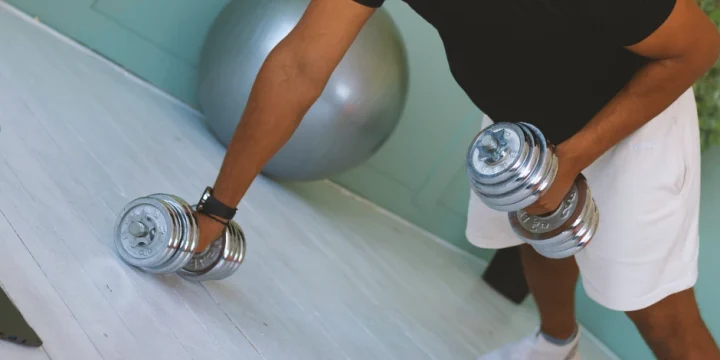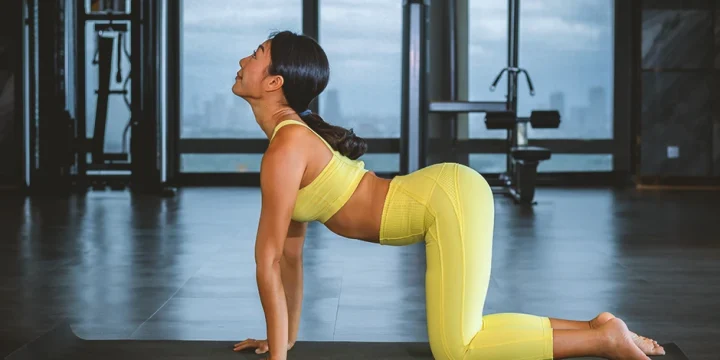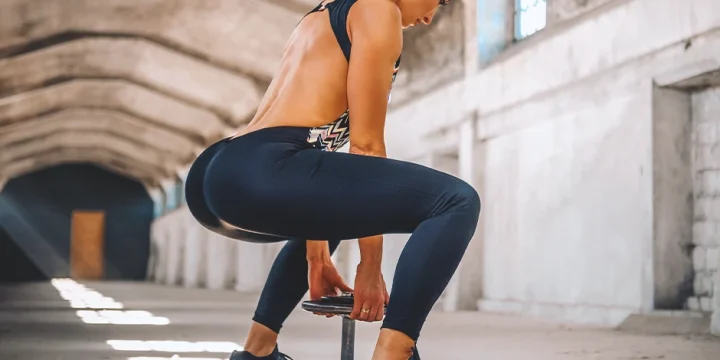As a fitness coach with a strong focus on optimizing performance and preventing injuries, I understand the importance of hip mobility in achieving an optimal range of motion and maintaining proper form during exercise.
Through several days of research and experience, I have created a list of the best hip mobility exercises to lengthen your hip flexors and help you overcome any limitations caused by restricted hip mobility.
In this guide, you will find scientifically-backed benefits of these exercises, providing you with the knowledge and tools to unlock your full potential.
Quick Summary
- Key exercises for enhancing hip mobility are Leg Swings, Lying Hip Rotations, Kneeling Lunge Stretch, Cossack Hovers, Clamshell, Butterfly Hip Stretch, Frog Hip Stretch, and Pigeon Stretch.
- To achieve the best results, these hip mobility exercises should be done three to four times a week, particularly before engaging in lower body workouts.
- According to the International Journal of Sports Physical Therapy, improved hip mobility not only benefits the hip joint but also the entire kinetic chain, reducing joint deterioration and promoting long-term joint health.
- In my opinion, dedicating time to hip mobility exercises is a crucial aspect of any fitness regimen, vital for sustaining joint health and enhancing overall physical functionality.
Top Hip Mobility Exercises

1. Leg Swings
Leg Swings have been a game-changer in my routine for loosening up tight hips before runs.
How to do this exercise:
- Stand perpendicular to a wall resting your left hand on the wall for support.
- Swing your left leg forward and back. Refrain from over-arching your back or flexing forward too much throughout the movement.
- Finish ten reps and switch to the other leg.
2. Lying Hip Rotations
From my experience, Lying Hip Rotations effectively alleviate the stiffness I feel after long hours of sitting.
How to do this hip flexor stretch:
- Lay down on a preferred workout mat with your knees bent and your feet planted flat on the floor.
- Position your right ankle over your left knee.
- Slowly lower the outside of your left leg and the bottom of your right foot toward the ground.
- Hold at the bottom, then return to starting position.
- Repeat this movement for several minutes.
3. Kneeling Lunge Stretch
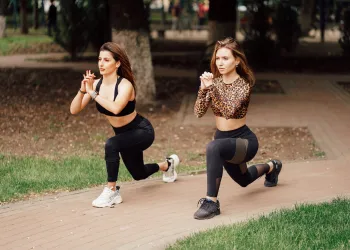
I've found the Kneeling Lunge Stretch essential for improving my hip flexibility, especially after leg days.
How to do this exercise:
- Get in a lunge position with your right leg dropped on the ground.
- Maintain this position for twenty to thirty seconds, making sure your front knee won't go over your toes.
- Slightly push your hips forward, keeping your chest up.
- Switch to the other leg.
"While doing the exercise, you should only lean back to release yourself from the stretch. Don't lean back while doing the kneeling hip flexor stretch. Instead, you should lean slightly forward for a better stretch of the muscles."
- Disheeta Maheshwari, Fitness Editor
Related: Side Lunges Stretches to Add Improvements to Your Workouts
4. Cossack Hovers
Cossack Hovers have been crucial in increasing my lateral hip mobility, a must for my dynamic workouts.
How to do this hip mobility exercise:
- Get in a wide stance.
- Switch your weight to the left side and perform a side lunge by bending your left knee and sending your hips back. Keep your spine tall and chest lifted.
- Extend your right leg to the side while turning the heel toward the ceiling about thirty to forty degrees.
- Switch to the right side.
- Continue alternating between left and suitable for the desired repetitions or time.
5. Clamshell
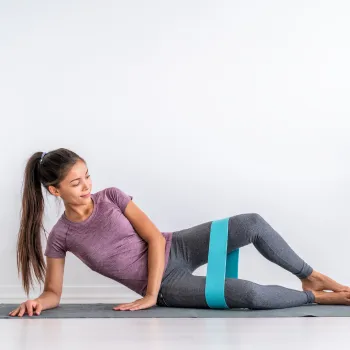
Integrating Clamshells into my routine dramatically improved my hip stability, especially beneficial during my hikes.
How to do this exercise:
- Lay on your right side on a mat, ensuring your hips and shoulders are stacked.
- Flex your knees while keeping your feet together.
- Lift your left knee while keeping your feet together. Place your hand on your left hip to prevent your body from rolling back and forth. Keep the upper body relaxed.
- Lower your knees back to return to the starting position.
- Repeat this movement for one minute, then alternate to the other leg.
Related: Clamshell Exercise: Why Should You Do It and How to
6. Butterfly Hip Stretch
I often use the Butterfly Hip Stretch to relieve tension in my inner thighs after long cycling sessions.
How to do this exercise:
- Sit on the ground.
- Bring your feet so they face each other, with the soles of your feet together.
- Bend your knees and gently use your arms to push them away, opening up the inner thighs.
- Lean your upper body forward to feel a stretch in your lower back.
- Maintain this position and continue the stretch for two minutes, focusing on deepening the stretch.
"If you're looking to level up and give your hips some extra love, a 90/90 hip stretch is a great complement to the butterfly stretch. This position will give a different form of resistance on the adductors while adding a quad stretch into the mix."
- Ash Wilking, Certified Personal Trainer
7. Frog Hip Stretch
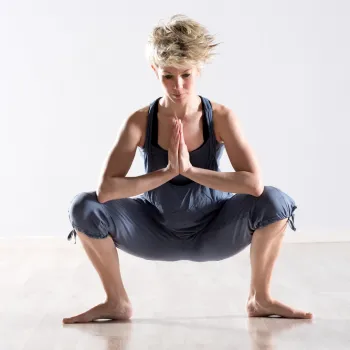
The Frog Hip Stretch has been a key exercise in enhancing my hip flexibility for deeper squats.
How to do the frog hip stretch:
- Assume a deep squat position, with your feet positioned outward and flat on the ground.
- Position your hands on the floor and slowly move your body forward.
- Open your hips as wide as possible, ensuring they are aligned with your knees and your feet remain flat on the ground.
- Sink your torso towards the ground and pull your belly up to neutralize your spine.
- Slightly move forward and backward, feeling a stretching sensation in your hips.
- Repeat this movement for ten pulses, then hold the stretch for ten seconds.
Learn More: Best Stretches For Hip Pain
8. Pigeon Stretch
Incorporating the Pigeon Stretch into my post-run routine has significantly eased tension in my hips and glutes.
How to do this classic hip flexor stretch:
- Go on all fours with your knees aligned under your hips and your hands under your shoulders.
- Bring your right leg forward and cross the ankle in front of your left knee. Keep your back straight and your core activated throughout the movement.
- Use your left foot to gently crawl your leg backward, maintaining the position of your right knee and ankle. Direct your attention toward feeling a deep stretch in your right hip and glute.
- Once you reach a point where you feel an intense stretching sensation, hold the position and take deep breaths. Be mindful of keeping your lower back from rounding or collapsing.
- To come out of the stretch, use your resting leg's toes to push yourself back up to the all-fours position.
- Switch to the opposite side and repeat the stretch on the opposite leg.
"You can take the pose deeper by moving into another version known as king pigeon pose, which requires you to use both of your hands to pull your back foot forward towards your forehead."
- Julia Sarah Hennig, Fitness Trainer
Other Stretch Articles:
What Are the Benefits of Increased Hip Mobility?

From my experience, the benefits of increased hip mobility are increased range of motion (ROM), relieved stress, reduced discomfort and injuries, improved joint health, enhanced physical performance, and improved posture.
- Improved range of motion - Increasing hip mobility allows for a greater range of motion in the hip joint, preventing the pelvis from posteriorly tilting and reducing the risk of low back pain.
- Stress relief - Hip mobility exercises can help alleviate stress and tension in the hips and surrounding muscles, promoting relaxation and well-being.
- Variation - Incorporating hip mobility exercises into your fitness routine adds variety, keeping your workouts exciting and helping you stay motivated.
- Enhanced recovery and warm-up - Hip mobility exercises can serve as low-intensity workouts, aiding recovery from intense training sessions and serving as a healthy hip joint warm-up before engaging in more vigorous exercise.
- Knots and injury prevention - Maintaining proper hip mobility is crucial for reducing the risk of injuries, particularly in sports that involve dynamic movements. Tight or immobile hips can lead to muscle imbalances, resulting in knee and hip pain. By performing hip flexibility and mobility exercises, you can mitigate the risk of such injuries, according to the Advances in Physical Education [1].
- Alleviated pelvis and lower back pain - Enhancing hip extension mobility and strength is essential in both the recovery and prevention of low back pain. Addressing hip mobility can significantly improve overall spinal health [2].
- Improved joint health - Restricted hip mobility can have adverse effects not only on the hip joint but also throughout the entire kinetic chain, according to the International Journal of Sports Physical Therapy [3]. Improving hip mobility can reduce joint deterioration and promote long-term joint health.
- Enhanced physical performance - Incorporating a dynamic warm-up routine featuring hip mobility exercises help you release tight hips and positively impacts critical parameters such as vertical jump height, maximal strength, and isometric strength [4].
- Promotes Good Posture - By enhancing hip mobility, you can support good posture, reducing the risk of back pain, according to the International Journal of Environmental Research and Public Health [5].
A sedentary lifestyle is a major contributor to poor hip mobility. Prolonged sitting leads to shortening of the hip flexors and weakening of the glutes, impacting overall mobility. Incorporating exercises that counteract these effects is essential for maintaining healthy hip joints.
Focusing on the strength and flexibility of hip stabilizers, such as glutes, hip external rotators, and adductors, is key for enhancing hip mobility. Strengthening these muscles helps alleviate tightness and supports a more balanced and efficient movement pattern.
Related Articles:
FAQs
How Often Should You Practice Hip Mobility Exercises?
You should practice hip mobility exercises at least three times per week before and after your lower body workout. If you can allocate more time, consider dedicating five to ten minutes daily for targeted hip mobility exercises.
What Movements Are Bad for Hips?
Movements bad for hips are hanging leg lifts, crunches, sit-ups, deep squats, leg presses, and movements on uneven terrain. It is crucial to listen to your body and immediately cease any exercise that causes discomfort or pain. Instead, opt for alternative exercises that are safer and more beneficial for your hips.
References:
- https://www.scirp.org/journal/paperinformation?paperid=109006
- https://ssep.com.au/hip-mobility-low-back-pain/
- https://www.ncbi.nlm.nih.gov/pmc/articles/PMC3811738/
- https://dergipark.org.tr/en/download/article-file/2778311
- https://www.ncbi.nlm.nih.gov/pmc/articles/PMC7922112/
About The Author
You May Also Like
